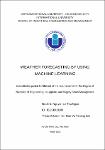| dc.description.abstract | Accurate weather forecasting is essential for numerous industries, including
agriculture, transportation, energy, and disaster preparedness. Recent advancements in
machine learning have sparked considerable interest in leveraging data-driven models
to enhance weather predictions. This thesis delves into the application of various
machine learning algorithms for weather forecasting, with a specific focus on
developing an ensemble approach to optimize predictive accuracy. To achieve this
objective, we employ the comprehensive London weather dataset, which spans a wide
array of meteorological variables over an extended timeframe. Our study evaluates the
performance of popular machine learning models, such as XGBoost, LSTM, GRU,
and Holt Winter, using the Root Mean Squared Error (RMSE) as the primary
performance metric. To explore the impact of different train-test split ratios on model
performance, sensitivity analysis is conducted. This analysis sheds light on the optimal
split ratio, with the 90-10 ratio emerging as the preferred choice. This knowledge
serves as a pivotal component in our pursuit of developing an ensemble model that
seamlessly integrates the strengths of XGBoost and GRU. Our ensemble model
surpasses baseline XGBoost and individual models, demonstrating a significant
improvement in predictive accuracy. The integration of XGBoost and GRU harnesses
their complementary strengths, enabling the ensemble to capture complex patterns and
temporal dependencies in the weather data effectively. Furthermore, we conduct
feature importance analysis, which yields invaluable insights into the most influential
variables driving weather patterns and predictions. Understanding these key drivers is
crucial for gaining a deeper understanding of the underlying dynamics and improving
the overall model performance. | en_US |


